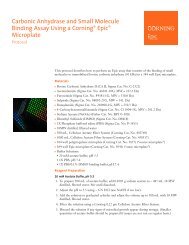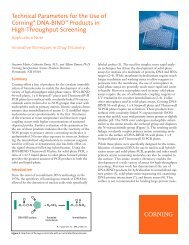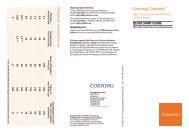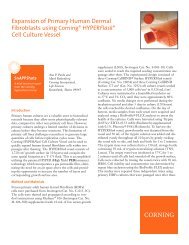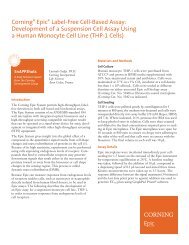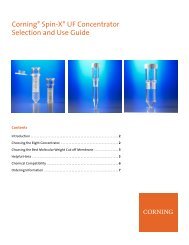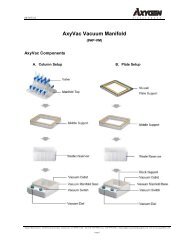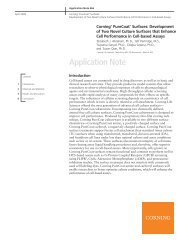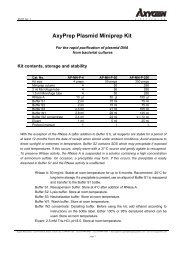Label-free optical biosensor for probing receptor biology: theory
Label-free optical biosensor for probing receptor biology: theory
Label-free optical biosensor for probing receptor biology: theory
Create successful ePaper yourself
Turn your PDF publications into a flip-book with our unique Google optimized e-Paper software.
<strong>Label</strong>-<strong>free</strong> <strong>optical</strong> <strong>biosensor</strong> <strong>for</strong><br />
<strong>probing</strong> <strong>receptor</strong> <strong>biology</strong>: <strong>theory</strong>,<br />
modeling and applications<br />
Ye Fang, Ann M. Ferrie, Elizabeth Tran, Gary Li,<br />
Florence Verrier, Jun Xi, and Meenal Soni
Abstract<br />
<strong>Label</strong>-<strong>free</strong> <strong>optical</strong> <strong>biosensor</strong>s have migrated from a tool solely <strong>for</strong> biomolecular<br />
interaction analysis to a universal plat<strong>for</strong>m <strong>for</strong> both biochemical and cell-based<br />
assays. This poster presents the theoretical analysis and experimental data <strong>for</strong> the<br />
use of resonant waveguide grating (RWG) <strong>biosensor</strong>s to characterize stimulusmediated<br />
cell responses including <strong>receptor</strong> signaling. The <strong>biosensor</strong> is capable of<br />
detecting redistribution of cellular contents in both directions that are perpendicular<br />
and parallel to the sensor surface. This capability relies on online monitoring cell<br />
responses with multiple <strong>optical</strong> output parameters, including the changes in incident<br />
angle and the shape of the resonant peaks. When the changes in the peak shape<br />
are mainly contributed to stimulation-modulated inhomogeneous redistribution of<br />
cellular contents parallel to the sensor surface, the shift in the incident angle<br />
primarily reflects the stimulation-triggered dynamic mass redistribution (DMR)<br />
perpendicular to the sensor surface. The <strong>optical</strong> signatures are obtained and used<br />
to characterize several cellular processes, particularly <strong>receptor</strong> signaling. A<br />
mathematical model is developed to link the bradykinin-mediated DMR signals to<br />
the dynamic relocation of intracellular proteins and the <strong>receptor</strong> internalization<br />
during B2 <strong>receptor</strong> signaling cycle. Chemical <strong>biology</strong> and cell <strong>biology</strong> analysis<br />
provides evidence linking specific cellular events to a ligand-induced DMR signal.<br />
Together with recent advancement in instruments <strong>for</strong> high throughput screening, the<br />
newly discovered ability of <strong>optical</strong> <strong>biosensor</strong>s <strong>for</strong> assaying living cells will accelerate<br />
wide adoption of label-<strong>free</strong> <strong>biosensor</strong>s in both drug discovery processes and<br />
fundamental research.<br />
Corning Incorporated<br />
2
Corning ® Epic ® System<br />
The Corning Epic System is a high-throughput, label-<strong>free</strong> detection plat<strong>for</strong>m that<br />
consists of SBS-standard 384-well microplates with <strong>optical</strong> sensors inside each well,<br />
an HTS-compatible microplate reader and a set of label-independent assay<br />
protocols. The Epic System is applicable to both biochemical and cell-based assays,<br />
and enables high-throughput screening of “intractable” targets.<br />
8<br />
+<br />
=<br />
Response (pm)<br />
6<br />
4<br />
2<br />
K D = 53 nM<br />
R 2 = 0.9707<br />
0<br />
0 500 1000 1500 2000 2500 3000<br />
[Acetazolamide] (nM)<br />
Microplate<br />
• 384-well <strong>for</strong>mat<br />
• Optical <strong>biosensor</strong> in each well<br />
• Surface chemistry<br />
Plate Reader<br />
• Compatible w/ HTS automation<br />
• ≥ 40,000 wells/8hrs<br />
• Sensitivity of 5pg/mm 2<br />
(300Da drug to 75kDa target)<br />
Binding Data<br />
• Manipulated and<br />
analyzed by<br />
customer<br />
Corning Incorporated<br />
3
Corning ® Epic ® system is centered around resonant waveguide<br />
grating (RWG) <strong>biosensor</strong><br />
• An <strong>optical</strong> <strong>biosensor</strong> comprise an <strong>optical</strong> transducer <strong>for</strong> converting a molecular recognition<br />
event or a stimulus-induced cellular response into a quantifiable signal<br />
Resonant waveguide<br />
grating<br />
(RWG)<br />
Y<br />
Y<br />
Y Y Y Y<br />
Y<br />
Waveguide<br />
Glass<br />
Intensity<br />
Broadband light<br />
Reflected light<br />
Wavelength (pm)<br />
Epic Microplate<br />
• 384-well <strong>for</strong>mat<br />
• Optical <strong>biosensor</strong><br />
in each well<br />
Fang, Y. (2006) Assays Drug Dev. Tech. 4, 583-595<br />
Corning Incorporated<br />
4
Corning® Epic® system is applicable to both biochemical and cellbased<br />
assays<br />
• Corning® Epic® system is the first label-<strong>free</strong> and high throughput <strong>biosensor</strong><br />
system <strong>for</strong> both biochemical and cell-based assays<br />
Biochemical assays Cell-based assays<br />
Drug<br />
Cell<br />
Protein<br />
150 nm<br />
Pos<br />
DMR<br />
Neg<br />
DMR<br />
Detection Zone<br />
150 nm<br />
Epic ® Biosensor<br />
Epic ® Biosensor<br />
Fang, Y. (2006) Assay Drug Develop. Technol. 4, 583-595<br />
Cooper, M.A. (2006) Drug Discov. Today 11, 1061-1067<br />
Morrow, Jr. K.J. Genetic Engineering & Biotechnology News 36 (March 1, 2008)<br />
Corning Incorporated<br />
5
G protein-coupled <strong>receptor</strong> signaling: temporal and spatial dynamics<br />
Late endosomes<br />
Lysosomes<br />
Degradation<br />
Endocytosis<br />
Early endosomes<br />
Synthesis<br />
k on<br />
Recycling<br />
k off<br />
Golgi<br />
1-5min 5-20min 20-60min >60min<br />
Corning Incorporated<br />
6
Evolution of <strong>receptor</strong> signaling<br />
• Linear signaling cascades<br />
• Network interactions<br />
• Cross-talks<br />
– Receptor dimerization/oligomerization<br />
– Transactivation and transinactivation<br />
– Networks with critical nodes that<br />
participate in the crosstalk between<br />
the signaling networks<br />
• Signaling compartmentalization<br />
– Microdomains<br />
– Organization of signaling complexes<br />
– Restricted collusion and diffusion<br />
– Spatial and temporal gradients<br />
• Signaling integration<br />
• Phenotypic <strong>receptor</strong> <strong>biology</strong><br />
– Cellular context-dependent<br />
– Tissue-specific<br />
C.M. Taniguchi, B. Emanuelli, C. R.Kahn (2006)<br />
Nat. Rev. Mol. Cell Biol. 7, 85 - 96<br />
Corning Incorporated<br />
7
RWG <strong>biosensor</strong> detects stimulus-induced dynamic mass<br />
redistribution (DMR) within cells<br />
The effective refractive index of the sensor system is:<br />
N<br />
n<br />
i<br />
The stimulus-induced change in refractive index (Δn i<br />
) of the homogeneous layer i approximately<br />
<strong>for</strong>m a piece-wise continuous function:<br />
Δn<br />
=<br />
=<br />
f<br />
n<br />
N<br />
o<br />
= αΔ<br />
i<br />
C i<br />
( n , h,<br />
n , n , n , d , λ , m,σ<br />
)<br />
c<br />
+ αC<br />
i<br />
F<br />
S<br />
m<br />
F<br />
A stimulus-induced change in the effective refractive index of the sensor system is:<br />
( Δnc,<br />
d ) = S(<br />
N ΔnC<br />
Δ N = f<br />
)<br />
The refractive index of a given volume within cells is largely determined by the concentrations<br />
of bio-molecules, mainly proteins:<br />
The stimulus-induced change in the effective index of the cell layer is:<br />
− zi<br />
− zi+<br />
1<br />
⎡ ⎤<br />
ΔZC<br />
ΔZC<br />
ΔnC<br />
= α∑(<br />
ΔCi<br />
⎢e<br />
− e ⎥)<br />
Epic® signal = f(C, d, t)<br />
i ⎢⎣<br />
⎥⎦<br />
Penetration<br />
depth ΔZC<br />
n i , z i , c i<br />
n F , d F<br />
n s<br />
Fang, Y., et al. (2006) Biophys. J. 91, 1925-1940<br />
Corning Incorporated<br />
8
Dynamic relocation of cellular context in G q -couple <strong>receptor</strong> signaling:<br />
basis <strong>for</strong> numerical modeling<br />
• Common to Gq-coupled <strong>receptor</strong> is the dynamic relocation of cellular targets:<br />
– Protein kinase C iso<strong>for</strong>ms<br />
– GPCR kinases<br />
– Arrestins<br />
– PIP-binding proteins<br />
– Diacylglycerol-binding proteins<br />
Bradykinin stimulation causes relocation of<br />
PKCθ-GFP to cell membrane in A431<br />
Sato, T.K., et al., Science<br />
294, 1881-1885.<br />
PKCθ-GFP<br />
0min<br />
6min<br />
Van Baal, et al. (2005) J. Biol.<br />
Chem. 2005, 280, 9870<br />
Corning Incorporated<br />
9
Numerical analysis predicts an <strong>optical</strong> signal that is similar to those<br />
obtained using RWG <strong>biosensor</strong><br />
L<br />
k<br />
+<br />
←<br />
k<br />
R ⎯⎯→<br />
f<br />
r<br />
k<br />
p<br />
LR ⎯⎯→ R<br />
*<br />
kin<br />
⎯⎯→ R<br />
in<br />
kre<br />
⎯⎯→ R<br />
For the net change in protein concentration adjacent to<br />
the cell surface :<br />
dC i<br />
dt<br />
= ak<br />
p<br />
[ LR]<br />
− bk [ R*]<br />
in<br />
Recruitment<br />
Internalization<br />
Theory predicated<br />
Experimental results<br />
Respones (unit)<br />
B<br />
4<br />
3<br />
2<br />
1<br />
0<br />
0 600 1200 1800<br />
Time (s)<br />
128nM<br />
64nM<br />
32nM<br />
16nM<br />
8nM<br />
4nM<br />
2nM<br />
1nM<br />
Response (unit)<br />
3<br />
2<br />
1<br />
0<br />
-1<br />
32nM<br />
8nM<br />
2nM<br />
0.5nM<br />
64nM<br />
0 1000 2000 3000 4000 5000<br />
Time (sec)<br />
Bradykinin in A431<br />
(dual signaling)<br />
Fang, Y., et al. (2006) Biophys. J. 91, 1925-1940<br />
Corning Incorporated<br />
10
RWG <strong>biosensor</strong> differentiates cellular responses mediated through<br />
distinct classes of GPCRs<br />
thrombin<br />
epinephrine<br />
Lysophosphatidic acid<br />
G q<br />
β2AR<br />
G s<br />
LPA 1<br />
G i<br />
PAR 1<br />
Ca 2+ , Ca 2+<br />
DAG<br />
PKC<br />
PLC<br />
IP 3<br />
AC<br />
cAMP<br />
AC<br />
cAMP<br />
3.0<br />
1.0<br />
1.5<br />
Response (unit)<br />
2.0<br />
1.0<br />
0.0<br />
Response (unit)<br />
0.5<br />
0.0<br />
-0.5<br />
Response (unit)<br />
1.0<br />
0.5<br />
0.0<br />
-1.0<br />
0 600 1200 1800 2400 3000 3600<br />
Time (sec)<br />
-1.0<br />
0 600 1200 1800 2400 3000 3600<br />
Time (sec)<br />
-0.5<br />
0 600 1200 1800 2400 3000 3600<br />
Time (sec)<br />
Fang, Y., et al. (2007) J. Pharmacol. Tox. Methods 55, 314-322<br />
Corning Incorporated<br />
11
RWG <strong>biosensor</strong> assays detect complex GPCR signaling:<br />
Dual signaling pathways of endogenous bradykinin B 2 <strong>receptor</strong> in A431<br />
bradykinin<br />
G q<br />
G s<br />
B 2<br />
<strong>receptor</strong><br />
Response (unit)<br />
4<br />
3<br />
2<br />
1<br />
0<br />
G q pathway modulators<br />
HBSS<br />
500nM GF109203x<br />
Ca 2+ , Ca 2+<br />
cAMP<br />
Response (unit)<br />
5<br />
4<br />
3<br />
2<br />
1<br />
0<br />
G s pathway modulators<br />
1μM KT5720<br />
HBSS<br />
-1<br />
0 1000 2000 3000 4000 5000 6000<br />
Time (sec)<br />
-1<br />
0 1000 2000 3000 4000 5000 6000<br />
Time (sec)<br />
Fang, Y., et al. (2005) FEBS Lett. 579, 6365-6374<br />
Corning Incorporated<br />
12
RWG <strong>biosensor</strong> cell assays differentiate ligand-directed functional<br />
selectivity acting on β 2 AR<br />
250<br />
200<br />
-logEC 50 ±S.E. P-DMR(pm) N-DMR(pm) τ (s) t 1/2 (s)<br />
Weak partial agonist<br />
150<br />
100<br />
50<br />
0<br />
-50<br />
catechol<br />
HO<br />
HO<br />
3.30±0.07 152±13 0±3 130±15 289±42<br />
250<br />
200<br />
Partial agonist<br />
150<br />
100<br />
50<br />
0<br />
HO<br />
dopamine<br />
5.96±0.06 214±32 31±4 252±15 480±23<br />
-50<br />
HO NH 2<br />
250<br />
Strong partial agonist<br />
200<br />
150<br />
100<br />
50<br />
norepinephrine<br />
HO<br />
7.99±0.07 209±16 29±5 180±17 559±15<br />
0<br />
-50<br />
HO NH 2<br />
HO<br />
Full agonist<br />
250<br />
200<br />
150<br />
100<br />
50<br />
0<br />
-50<br />
HO<br />
HO<br />
(-)-epinephrine<br />
HO<br />
N<br />
H<br />
10.13±0.06 232±12 37±7 132±20 521±25<br />
Potency<br />
Efficacy Ability to cause<br />
<strong>receptor</strong> internalization<br />
60min<br />
Fang, Y. & Ferrie, A.M. (2008) FEBS Lett. 582, 558-564<br />
Corning Incorporated<br />
13
RWG <strong>biosensor</strong> cell assays enable systems cell <strong>biology</strong> analysis of<br />
<strong>receptor</strong> signaling<br />
EGFR<br />
EGF<br />
The MAPK pathway<br />
determines the EGFinduced<br />
DMR signal<br />
MEKK-1<br />
JNKK1<br />
JNK<br />
Ras<br />
Raf<br />
MEK<br />
ERK<br />
Sos-1<br />
Grb2<br />
Shc<br />
p<br />
p<br />
p<br />
p<br />
p<br />
p<br />
p<br />
STAT3<br />
p<br />
PIP2<br />
p<br />
p<br />
p<br />
DAG<br />
p<br />
PLCγ<br />
p<br />
p<br />
PI3K IP3<br />
PKC<br />
JAK1<br />
Ca 2+ , Ca 2+<br />
STAT1<br />
p<br />
p<br />
p<br />
p<br />
p<br />
p<br />
p<br />
p<br />
p<br />
p<br />
p<br />
p<br />
p<br />
p<br />
Dynamin<br />
Inhibitor<br />
AG1478<br />
Cytochalasin B<br />
DIPC<br />
GF109203x<br />
KN62<br />
KT5720<br />
KT5823<br />
Latrunculin A<br />
Milrinone<br />
Nocodazole<br />
PD98059<br />
Phalloidin<br />
PP1<br />
Ro 20-1724<br />
R(-)rolipram<br />
SB203580<br />
SB202190<br />
SP600125<br />
U0126<br />
Vinblastine<br />
Wortmainnin<br />
Zardaverine<br />
Target<br />
EGFR<br />
Actin<br />
Dynamin<br />
Protein Kinase C<br />
CaM Kinase II<br />
Protein Kinase A<br />
Protein kinase G<br />
Actin<br />
Phosphodiesterases<br />
Microtubule<br />
MEK<br />
Actin<br />
Src<br />
Phosphodiesterases<br />
Phosphodiesterases<br />
p38 MAPK<br />
p38 MAPK<br />
JNK<br />
MEK1/2<br />
Microtubule<br />
PI3K<br />
Phosphodiesterases<br />
c-Jun<br />
STAT3<br />
ELK-1 FAK<br />
Cell detachment<br />
STAT1<br />
Response (unit)<br />
3.0<br />
2.5<br />
2.0<br />
1.5<br />
1.0<br />
0.5<br />
0.0<br />
-0.5<br />
HBSS<br />
ELK-1<br />
AG1478<br />
U0126<br />
SB203580<br />
SB202190<br />
SP600125<br />
GF109203x<br />
KT5720<br />
KN62<br />
KT5823<br />
Wortmannin<br />
DIPC<br />
Cytochalasin B<br />
Latrunculin A<br />
Milrinone<br />
Zardaverine<br />
Ro20-1724<br />
Rolipram<br />
Compound<br />
Modulation Profile<br />
Fang, Y., et al. (2005) Anal. Chem. 77, 5720-6725<br />
Fang, Y., et al. (2006) Biochem. Biophys. Acta 1763, 254-261<br />
Corning Incorporated<br />
14
Summary<br />
• Epic ® cell assays employ label-<strong>free</strong> <strong>optical</strong> <strong>biosensor</strong> to measure stimulusinduced<br />
dynamic mass redistribution in cells within the detection zone of the<br />
<strong>biosensor</strong><br />
• The DMR signal is a novel physiologically relevant and kinetic response of living<br />
cells<br />
• The DMR signal is a global representation of <strong>receptor</strong> <strong>biology</strong> and ligand<br />
pharmacology<br />
• Epic cell assays have broad applicability in many classes of targets, and have<br />
potentials in drug discovery and development process as well as others<br />
Corning Incorporated<br />
15



